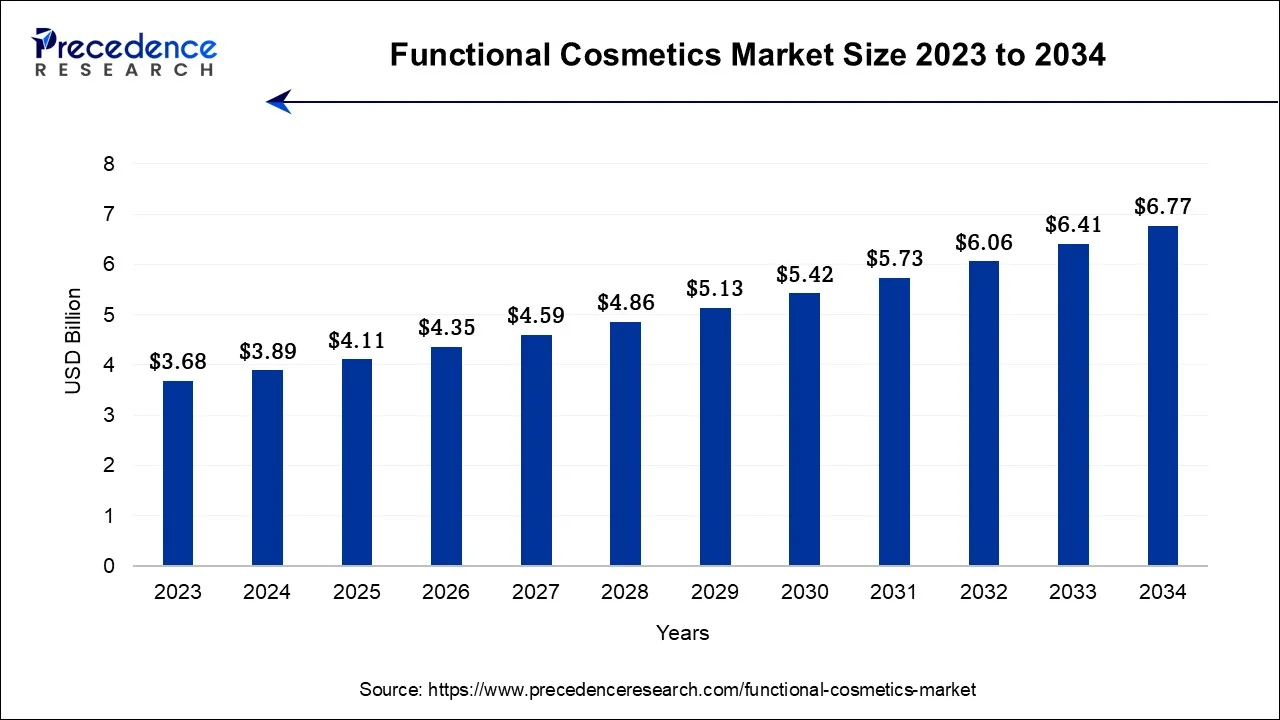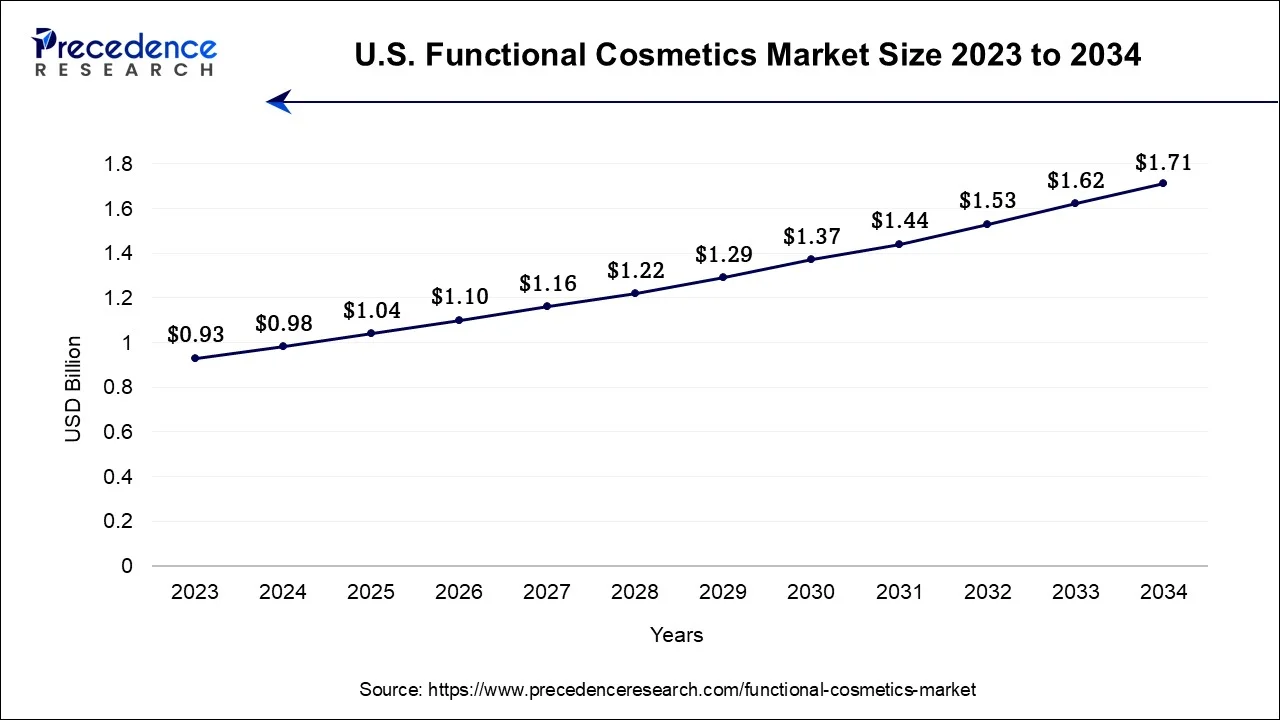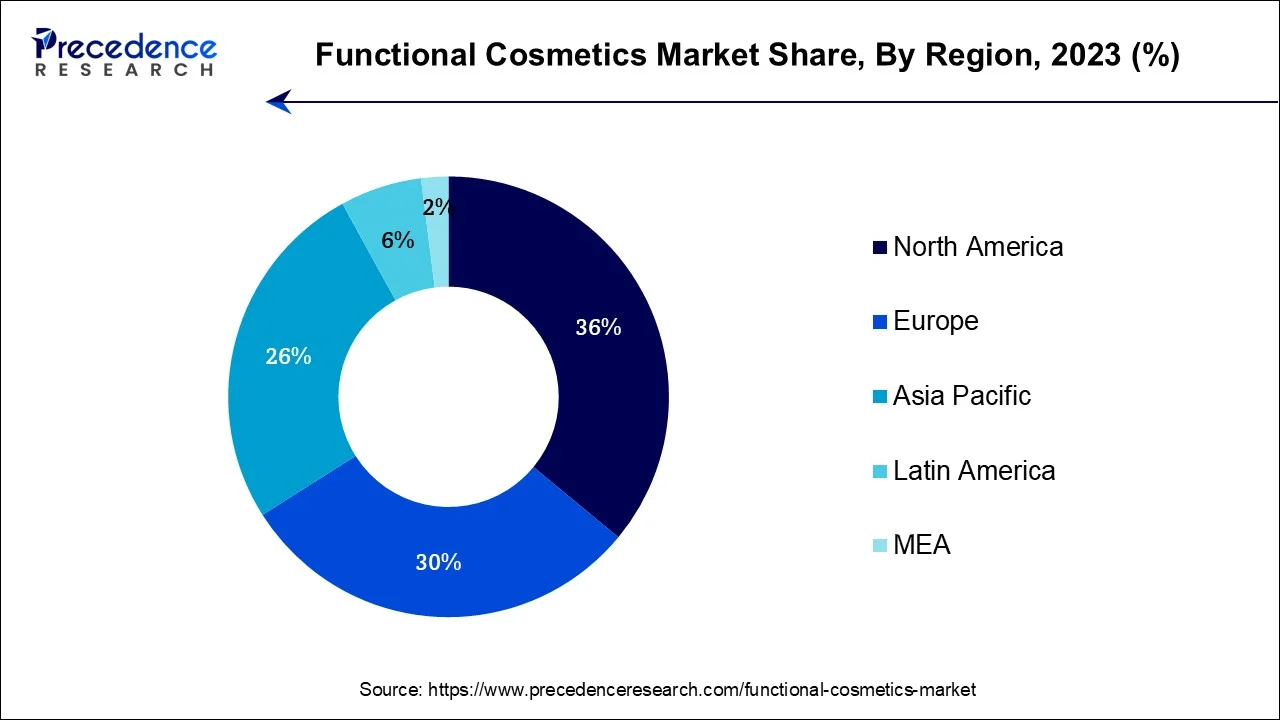November 2024
The global functional cosmetics market size is predicted to increase from USD 3.89 billion in 2024, grew to USD 4.11 billion in 2025 and is anticipated to reach around USD 6.77 billion by 2034, poised to grow at a CAGR of 5.70% between 2024 and 2034. The North America functional cosmetics market size is calculated at USD 1.40 billion in 2024 and is estimated to grow at a fastest CAGR of 5.71% during the forecast year.
The global functional cosmetics market size accounted for USD 3.89 billion in 2024 and is predicted to be worth around USD 6.77 billion by 2034, poised to grow at a CAGR of 5.70% between 2024 and 2034.

The U.S. functional cosmetics market size is estimated at USD 0.98 billion in 2024 and is expected to expand around USD 1.71 billion by 2034, growing at a CAGR of 5.72% from 2024 to 2034.

North America has held the largest revenue share 36% in 2023. In North America, the functional cosmetics market is witnessing several key trends. There is a growing demand for clean and sustainable beauty products, with consumers seeking natural and eco-friendly formulations. The pandemic has boosted interest in skincare solutions that address issues arising from mask-wearing, such as masking. Additionally, the region's aging population is driving demand for anti-aging functional cosmetics. The rise of e-commerce and social media platforms has amplified product accessibility and allowed consumers to explore and purchase functional cosmetics online, contributing to market growth in North America.

Asia-Pacific is estimated to observe the fastest expansion. In the Asia-Pacific region, the functional cosmetics market has experienced dynamic growth. Consumers increasingly prioritize skincare products offering health-related benefits, driving demand for sun protection, anti-aging, and hydration-focused cosmetics. Natural and clean beauty formulations have gained traction. Influenced by K-beauty trends, innovative ingredients like snail mucin and hyaluronic acid have gained popularity. E-commerce platforms have surged as primary sales channels, particularly in countries like South Korea and China. With a growing middle class and rising disposable incomes, the Asia-Pacific functional cosmetics market is poised for continued expansion, representing a significant opportunity for brands that can cater to evolving consumer preferences.
In Europe, the functional cosmetics market is experiencing notable trends. Consumers are increasingly gravitating towards clean and sustainable beauty products, emphasizing natural ingredients and eco-friendly packaging. The wellness movement is influencing the market, with products addressing both beauty and health concerns gaining popularity. Multi-functional cosmetics that simplify skincare routines are in demand.
| Report Coverage | Details |
| Growth Rate from 2024 to 2034 | CAGR of 5.7% |
| Market Size in 2024 | USD 3.89 Billion |
| Market Size by 2034 | USD 6.77 Billion |
| Largest Market | North America |
| Base Year | 2023 |
| Forecast Period | 2024 to 2034 |
| Segments Covered | Functionality, Application, and Region |
| Regions Covered | North America, Europe, Asia-Pacific, Latin America, and Middle East & Africa |
Multi-functionality is a significant driver of market demand in the functional cosmetics sector. Consumers increasingly seek products that offer a range of benefits, such as skin care enhancements and health advantages like UV protection or anti-aging properties. Multi-functional cosmetics streamline beauty routines, providing convenience and efficiency. These products cater to the modern consumer's desire for holistic solutions, making it easier to address various needs with a single purchase.
As a result, the demand for functional cosmetics continues to surge as consumers prioritize products that deliver multiple, tangible benefits in one application. Moreover, consumer health and wellness awareness has significantly surged the market demand for functional cosmetics. As consumers prioritize self-care and seek products aligned with their well-being, they increasingly turn to cosmetics that offer both aesthetic enhancements and tangible health benefits.
Functional cosmetics, with features like sun protection, anti-aging properties, and skin hydration, resonate with health-conscious individuals. This heightened awareness drives a strong demand for products that not only enhance appearance but also contribute positively to overall health, thereby fueling the growth of the functional cosmetics market.
Cost constraints in the functional cosmetics market can limit market demand as they impact both manufacturers and consumers. For manufacturers, the formulation and sourcing of high-quality, active ingredients can be expensive, potentially affecting profit margins. This, in turn, may lead to higher product prices, making functional cosmetics less accessible to cost-conscious consumers. Additionally, research and development costs for innovative products can be substantial. Cost-conscious consumers may opt for more affordable alternatives, potentially hindering market growth for premium functional cosmetics.
Moreover, allergies and skin sensitivities restrain market demand for functional cosmetics due to concerns about adverse reactions. This can limit the adoption of certain products, especially those with active ingredients or harsh chemicals. Brands face the challenge of formulating hypoallergenic and dermatologist-tested cosmetics to accommodate sensitive consumers.
Additionally, stringent ingredient testing and compliance with safety regulations increase development costs. Consumer hesitancy resulting from potential allergic reactions constrains market growth, necessitating meticulous product safety and transparency efforts to regain consumer trust and expand the market.
Anti-aging innovations fuel market demand in the functional cosmetics sector by catering to a growing demographic seeking effective solutions for youthful skin. Advanced ingredients, such as peptides, retinol, and antioxidants, combined with cutting-edge technologies like stem cell research and microencapsulation, promise visible results. As the aging population seeks products that reduce fine lines, wrinkles, and other signs of aging, the demand for these innovative functional cosmetics surges, driving market growth and spurring continuous research and development in the quest for age-defying beauty.
Moreover, wellness collaborations drive market demand for functional cosmetics by creating holistic beauty and health solutions. Partnering with wellness brands and professionals, such as nutritionists, fitness trainers, and mental health experts, allows functional cosmetics brands to offer comprehensive well-being packages. These collaborations emphasize the interconnectedness of inner health and outer beauty, resonating with consumers seeking a holistic approach to self-care. The combined expertise and endorsements from wellness experts instill trust and credibility, making functional cosmetics a sought-after choice for those looking to enhance both their appearance and overall wellness.
According to the functionality, the Conditioning Agents sector held 36% revenue share in 2023. Conditioning agents in functional cosmetics refer to ingredients that improve the texture, manageability, and overall health of hair and skin. These agents often provide moisturization, reduce frizz, and enhance shine, offering both aesthetic and functional benefits. Trends in the functional cosmetics market show a growing demand for natural and eco-friendly conditioning agents. Consumers seek products with plant-based extracts, sustainable sourcing, and minimal environmental impact. Additionally, multifunctional conditioning agents that offer enhanced hair and skin protection, such as UV or pollution defense, are gaining popularity, aligning with the broader trend of holistic beauty and wellness.
The Skin lightening agent segment is anticipated to expand at a significant CAGR of 7.8% during the projected period. Skin-lightening agents in functional cosmetics refer to ingredients or formulations designed to reduce the appearance of hyperpigmentation, dark spots, or uneven skin tone. These agents work by inhibiting melanin production or promoting its even distribution, leading to a brighter complexion. In the functional cosmetics market, there is a growing trend towards natural and botanical-based skin lightening agents due to consumer demand for safer, eco-friendly products. Additionally, multi-functional products that combine skin lightening with other benefits like hydration or sun protection are gaining popularity, reflecting the market's focus on convenience and efficacy.
The skin care held the largest market share of 59% in 2023. Skincare within the functional cosmetics market refers to products designed to enhance skin health, and appearance, and address specific concerns. Trends in this segment include a shift towards clean and natural formulations, incorporating ingredients like hyaluronic acid and vitamin C for hydration and anti-aging benefits. Personalization is gaining traction, with consumers seeking tailored solutions for various skin types. Moreover, anti-pollution and blue-light protection are emerging concerns, driving the development of cosmetics that shield against environmental stressors. The growing demand for sustainable packaging and ethical practices further defines modern skincare trends in the functional cosmetics market.
On the other hand, the hair care segment is projected to grow at the fastest rate over the projected period. Hair care in the functional cosmetics market refers to products designed to enhance the health and appearance of hair. These products include shampoos, conditioners, serums, and masks that offer benefits such as strengthening, volumizing, smoothing, or promoting hair growth. Recent trends in hair care functional cosmetics involve a shift toward clean and natural ingredients, addressing specific hair concerns like scalp health, and the use of advanced technologies like stem cell therapy and biotin-infused formulations. Sustainable packaging and inclusivity with products catering to diverse hair types and textures are also becoming prominent trends in this segment.
Segments Covered in the Report:
By Functionality
By Application
By Geography
For inquiries regarding discounts, bulk purchases, or customization requests, please contact us at sales@precedenceresearch.com
No cookie-cutter, only authentic analysis – take the 1st step to become a Precedence Research client
November 2024
November 2024
October 2023
July 2024